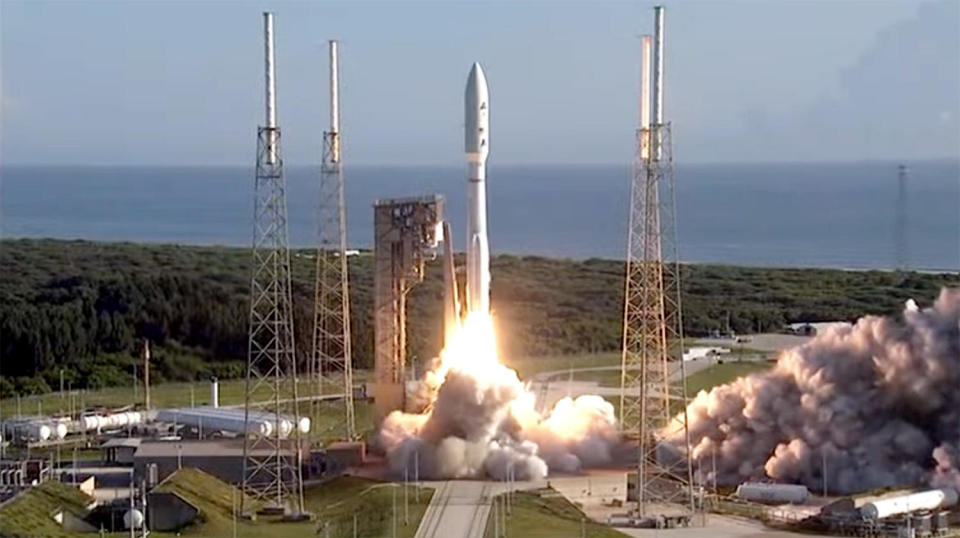Atlas 5 rocket launches National Reconnaissance Office "watchdog" satellites
A United Launch Alliance Atlas 5 rocket blasted off and boosted multiple National Reconnaissance Office satellites into space Sunday to keep tabs on the behavior of potential enemy spacecraft in the high orbit favored by spy satellites, communications stations and other high-priority U.S. assets.
The NROL-107 payload, made up of an unknown number of satellites built to operate in geosynchronous orbit 22,300 miles above the equator, is known as "Silent Barker."

"The idea of the mission is to put a satellite in geosynchronous orbit, and then to be looking at that orbital regime and get a sense of what's happening day to day," said NRO Director Chris Scolese.
Along with tracking routine satellite movements, "we also want to know if there is something going on that is unexpected, or shouldn't be going on that could potentially represent a threat to a high-value asset, either ours or one of our allies," Scolese said.
"So that's the purpose of it. It's really to be a watchdog in that orbital regime, the geosynchronous orbit."
The Atlas 5, powered by a Russian-built RD-180 first stage engine and five GEM-63 strap-on solid-fuel boosters, roared to life and climbed away from pad 41 at the Cape Canaveral Space Force Station at 8:47 a.m. ET.
The launching, delayed from Aug. 29 by Hurricane Idalia and then by a technical issue, marked the 18th and final Atlas 5 NRO flight as ULA continues its on-going transition to the company's new Vulcan rocket.

While the general purpose of the NROL-107 payload was openly discussed by the NRO, details about the ascent and the orbital parameters of the Silent Barker satellites were classified. As a result, ULA ended its launch commentary as the rocket's first stage was finishing it's "burn" and no other details about the flight were immediately available.
But the nature of geosynchronous orbit is well understood. At that altitude, satellites take 24 hours to complete one orbit, rotating in lockstep with Earth and appearing stationary in the sky. That allows hemispheric coverage for electronic eavesdropping spy satellites, for example, military and commercial data relay stations, weather satellites and others.
In a major conflict, military reconnaissance and communications satellites would be prime targets for anti-satellite weapons and before that, targets for close-range inspection by adversary spacecraft. China and Russia both are thought to have satellites able to maneuver, rendezvous with, inspect and possibly interfere with U.S. and ally spacecraft.
The secretive NRO seldom discusses its payloads, but in the case of Silent Barker, officials said they wanted potential adversaries to understand America's ability to keep tabs on any such threats to in the so-called "geo belt," which is difficult to monitor from Earth's surface given the distances involved and the vagaries of weather and lighting.
"A huge element of deterrence is the ability for the adversary to know what we can and cannot see," said Lt. Gen. Michael Guetlein, commander of Space Systems Command for the U.S. Space Force. "So we actually want our competitors to know that we have eyes in geo, that we can see what's happening.
"Not only are we going to maintain the custody and the ability to detect what's going on in geo, but we'll have the indications and warnings to know there's something out of the normal occurring. And that goes a long way towards deterrence."
Sunday's launch was the first of at least two planned Silent Barker-type missions. The program is expected to be fully operational in 2026.
"What Silent Barker is going to do is provide that indication and warning so it can inform decisions about what we do or don't need to do in terms of maneuver or awareness," Scolese said. "So it's a great increase in our understanding of what we'll be able to do and will greatly improve our ability to determine future courses of action."
Pennsylvania authorities concerned escaped killer will try to steal another vehicle
Everything we know about Putin and Kim Jong Un's planned meeting
Survivors of Morocco earthquake building makeshift encampments, multiple factors slowing relief

